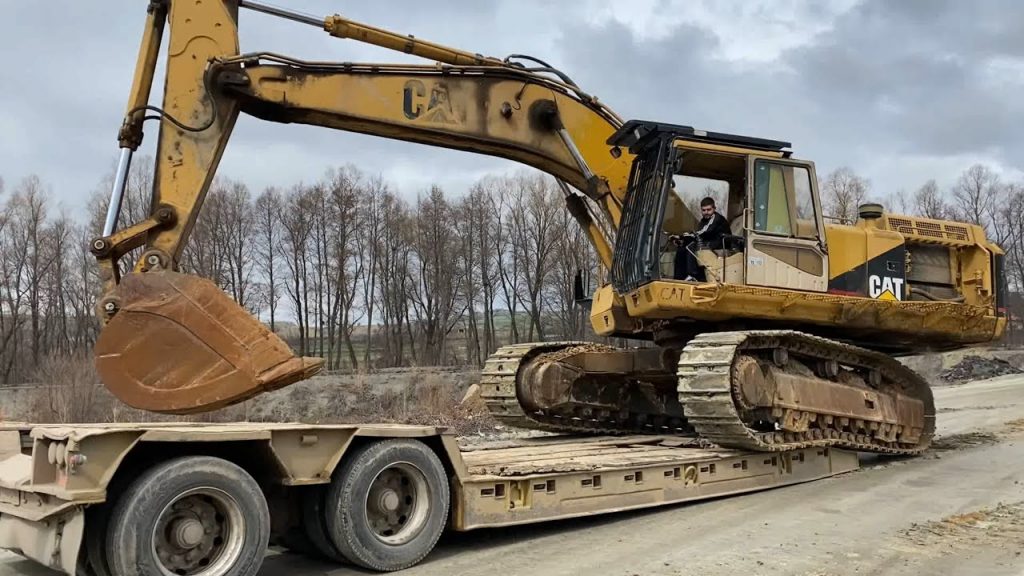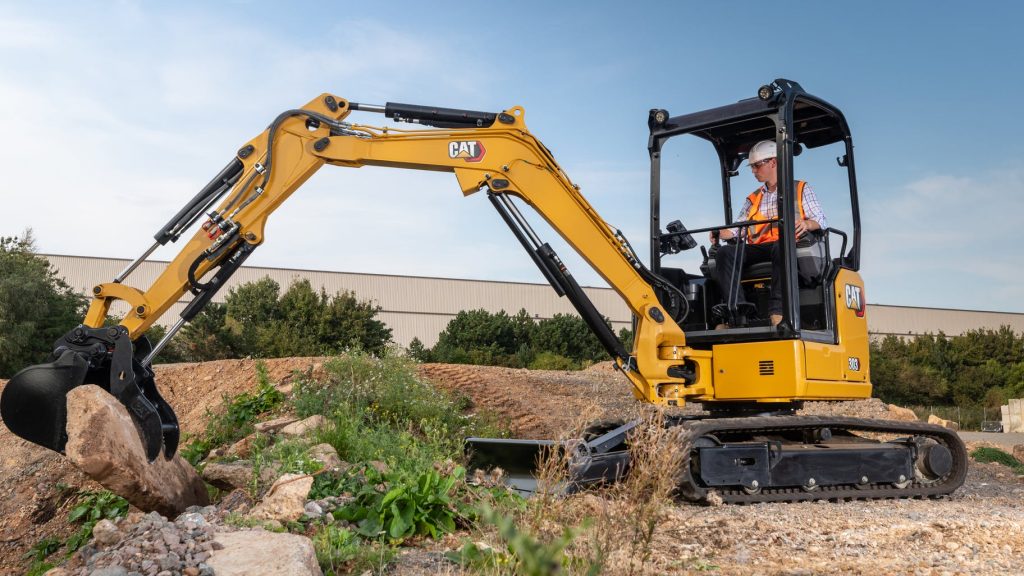Cat excavator has a long history in the field of construction. However, many people have not received such machines, they heard only the name and do not know how this machine works and what is its advantage. Here we will tell you about the common problems and solutions.
cat excavator doesn’t turn left or right
If your Cat excavator doesn’t turn left or right, then it’s likely that you have a problem with your pilot system or the final drive. In this article, we will walk you through potential fixes for issues related to track movement.
The pilot system is what allows the operator to control the movement of the excavator tracks. The pilot system is made up of three components: a pump, relief valve and control valve. Each of these components must be working correctly in order for the excavator to turn left and right.
The final drive is where the power from your engine is converted into motion. If there is an issue with your final drive, then you could experience difficulty with your excavator turning left and right, even if the pilot system is working properly.

cat excavator doesn’t move forward and reverse
the transmission is a Cat 3306, they are very reliable. The transmission has two filters and the first one is in line with the fuel tank, the second one is under the toolbox to the left of the seat.
If you take the top cover off there are 6 large bolts that hold it on. The two outer most bolts have wires going to them, disconnect these wires and bolt them off. Then remove the remaining 4 large bolts and lift off top cover. I would also clean up any leaks on top of cover before replacing.
When you get cover off you will see an electric motor bolted to side of transmission, this is what has failed. It is easy to see which wire goes to which connector if you pull connectors out and trace wires back out of machine.
You can unbolt motor carefully and remove it with a hoist or block and tackle like I did since I don’t have hoist handy. It would be a good time to replace lines going into motor as well. There are two o-rings that keep oil from leaking out at each end of motor shaft. So make sure they are in place when you reinstall motor.
cat excavator engine overheating
If the temp is too high, shut off the engine and let it cool down. First determine where the leak is coming from – radiator or water pump. If it’s a water pump, you will have to replace it. It’s not something you can fix. No gaskets to replace, no sealer to use. One of the reasons for this is that the water pump is constantly under pressure in an excavator and sealers and gaskets just don’t work in that situation.
If it’s a radiator, try replacing the radiator cap first. If that doesn’t work, check all hose connections for leaks. If everything looks ok there, then you will have to take out the radiator and take it to a radiator shop to get repaired or replaced. It will cost you but might be less expensive than replacing the entire machine if it catches fire because of an overheating problem.
1. Low coolant level.
2. Dirty or damaged radiator and/or air conditioning condenser.
3. Loose fan belt(s).
4. Faulty fan clutch.
5. Faulty coolant temperature sensor.
6. Mechanical pump failure or low pressure from a worn out pump seal (leaking coolant internally).
7. Water pump failure (leaking water internally).
cat excavatorengine oil pressure low
A low engine oil pressure warning light can indicate a lack of lubrication, which can cause serious engine damage. If the warning light comes on, stop the machine, check the oil level and add as necessary. If the light stays on after adding oil, shut off the engine and inspect for possible leaks or other problems. Use caution when running the machine with a low pressure warning light on – this could lead to catastrophic failure.
To keep your equipment running safely and efficiently, change the engine oil and filters at regular intervals. Proper maintenance will help extend the life of your equipment.
1. Check your oil level in the sight glass. If it is low, fill with oil to the full mark.
2. Start the engine and run for about 30 seconds at low idle speed.
3. Stop the engine and wait 10 seconds.
4. Check the oil pressure again and refer to the following chart for normal pressure at various temperatures.
cat excavator Hydraulic system problems out
One of the most common problems with heavy equipment is hydraulic leaks. This can be a simple seepage of fluid (usually at a fitting) or a major leak from the housing at the main cylinder on the boom arm. The latter requires immediate attention and should never be ignored.
A smaller leak can usually wait until the job is completed, but it needs to be addressed before more damage occurs. A leaky connection can be fixed by tightening the connection or replacing an o-ring seal that may have worn out.
Before any maintenance is done, always assess the situation carefully and put safety first. Hydraulic systems run at very high pressures and can cause serious injury or death if caution is not taken!!!
1. Check whether the cylinder has a closed condition or an abnormal position.
2. Check whether the pilot valve block is stuck or blocked by debris. The solenoid valve is stuck or burned out.
3. Whether the valve block solenoid coil is burnt out or damaged due to water ingress.
4. Whether the main control valve block is leaking, stuck, or blocked by debris.
5. Whether there are any faults in the electrical system of the main control valve block.
cat excavator main pump and valve problems
1. Disconnect the oil pipe at the bottom of the valve bank and turn on the engine, if the oil is not coming out, that indicates that there is a problem with the main control valve or pilot control valve.
2. When only one of the two pumps is working, first check whether the hydraulic pump solenoid valve is stuck in place or not. If it is stuck, continue to check whether the hydraulic pump solenoid valve coil is short-circuited or damaged. If so, replace it immediately. After checking that all are normal, replace the new electromagnetic valve of this hydraulic pump according to the diagram. Otherwise, you need to check whether there is any debris in the electromagnetic reversing valve blocking channel.
3. When both pumps are not working, first check whether there are any problems with the main control valve or pilot control valve. If so, please disassemble and repair it immediately. If you find no problem during inspection, you can pull out the main power supply plug from PLC (Programmable Logic Controller) and then insert it again to see if it works properly. If still not solved yet, you have to open and check PLC itself by replacing
cat excavator air condition failures
The air conditioning system on your excavator is designed to circulate refrigerant, which absorbs and releases heat as it travels between the evaporator and condenser. The compressor pumps the refrigerant between these two units. If you have a problem with your compressor, it may not pump sufficient amounts of refrigerant through the system. This causes a reduction — or complete loss — of cool air from the vents.
Checking for Compressor Problems
1.Turn on the air conditioner in your excavator and let it run for five minutes or until it reaches its normal operating temperature. If the cool air from the vents decreases or stops completely, turn off the engine and open the hood.
2.Hold a thermometer inside one of the vents in the cab and record the temperature. Then press down on the clutch pedal, which should engage a belt-driven pulley attached to your compressor clutch assembly. Press down on the clutch several times to engage and disengage it, then check the temperature again. If there is no change in temperature when you engage and disengage your clutch, you likely have a problem with your compressor.
3.Remove one of the hoses running from your compressor to the condenser unit using a socket wrench or hose clamp remover
cat excavator transmission failures
A certain percentage of Cat excavator transmission failures will be the result of a catastrophic component failure or a sudden loss of hydraulic oil. But Caterpillar excavators are designed to operate in severe duty applications and, like all machines, will require some maintenance.
Transmission fluid is vital to the operation of your machine’s transmission. In fact, it is the only component that can be used to cool and lubricate the gears in your transmission. Cat transmission fluids are engineered to meet the demands of Cat transmissions and offer superior protection and performance.
Transmission oil samples should be taken at regular intervals and analyzed to determine if there is any contamination or metal wear. A metal-on-metal condition in an automatic transmission could lead to an early failure. The metal wear is caused by clutch material being pulled into the oil through worn seals or faulty shift valves. This is a common problem with automatic transmissions that use clutch discs for gear engagement.
Transmission oil analysis should show no metal wear or contamination beyond normal levels for your machine’s age and application.
cat excavator electrical failures
Cat excavators are heavy equipment used in construction to help with digging and moving large objects. Cat is a brand name, which stands for Caterpillar. The company is well-known and respected in the industry, but they can still have problems. Some of these problems may be electrical.
Cat excavator electrical failures may be caused by a faulty alternator. The alternator provides a steady stream of electricity to charge the battery and power the cab when the engine is running. If the alternator fails, the battery will run out of power and the engine will eventually shut down. The alternator needs to be checked for bad diodes or a damaged rotor.
The wiring harness may be broken and causing electrical problems on your excavator. Sometimes there are problems with moisture damage inside the cab that cause wiring issues, such as corrosion on wires or damaged wire insulation. These problems can be prevented by having extra wiring harnesses on hand so you can change it out at regular intervals, or when you notice signs of wear and tear.
The main fuse box could be malfunctioning if your Cat excavator is having electrical issues. The fuse box should be checked for loose wires and blown fuses, since these can both cause malfunctions in your equipment’s electrical system.
cat excavator Hydraulic Leaks and Low Fluid Levels
The cause of the leak or low fluid level may not be apparent through visual inspection. If a leak cannot be identified, perform the following:
Hydraulic oil leaks can occur at many points in the hydraulic system. The most common locations are at hose connections, seals and gaskets on components, control valves and cylinder rod seals.
Leaks can be classified as external or internal. External leaks are noticeable because of oil residue left on the machine. Internal leaks usually result in low hydraulic oil levels and poor machine performance.
Leaks can develop over time from normal wear and tear, or they can happen suddenly if a component fails catastrophically. Hydraulic fluids will also deteriorate over time and need to be replaced.
Low hydraulic oil levels can be caused by slow oil leaks, running the system with little or no oil in it or by excessive oil consumption (internal leakage) within components such as motors, pumps or cylinders.
When a hydraulic system exhibits signs of external or internal leakage, immediate action should be taken to identify the problem and repair it before further damage occurs to other components in the system.

cat excavator Electric Parts Failure
The construction machinery is used in the environment of the sun and rain, and the work is severe. Therefore, when the excavator electric parts are malfunctioning, it not only affects the operators’ normal operation and reduces their working efficiency, but also causes great damage to the electrical system and safety. In recent years, due to frequent lightning strikes, more and more electrical failures have occurred. The following describes some common electrical failures of excavators:
1. Frequent blowing fuses
2. Relay frequent action
3. The thermistor frequently works or does not work
4. Operating current is too high or too low
5. Insufficient power output of generator
6. The motor does not turn or runs slowly
7. The battery does not charge properly
